

Compact Muon Solenoid
LHC, CERN
| CMS-PAS-EXO-16-051 | ||
| Search for dark matter in final states with a top quark and missing transverse momentum using new hadronic top quark tagging techniques | ||
| CMS Collaboration | ||
| July 2017 | ||
| Abstract: A search for dark matter is conducted in events with large missing transverse momentum and a hadronically decaying, boosted top quark. This study is performed using proton-proton collision data at a center-of-mass energy of $\sqrt{s}= $ 13 TeV collected by the CMS detector at the LHC, corresponding to an integrated luminosity of 35.8 fb$^{-1}$. No significant deviations from standard model predictions are observed, and limits are placed on the production of new heavy bosons coupling to dark matter particles. | ||
|
Links:
CDS record (PDF) ;
inSPIRE record ;
CADI line (restricted) ;
These preliminary results are superseded in this paper, JHEP 06 (2018) 027. The superseded preliminary plots can be found here. |
||
| Figures | |

png pdf |
Figure 1:
Example of monotop production via a flavor-changing neutral current (left) and a heavy scalar (right). |
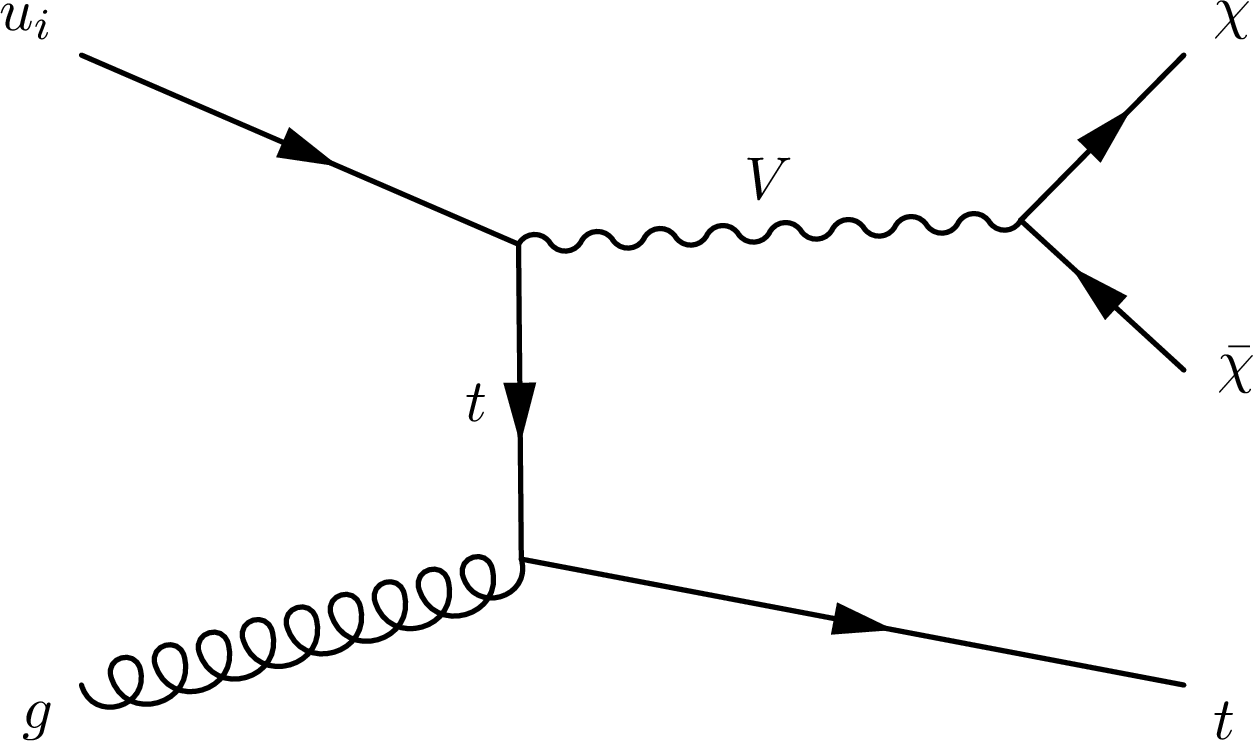
png pdf |
Figure 1-a:
Example of monotop production via a flavor-changing neutral current. |
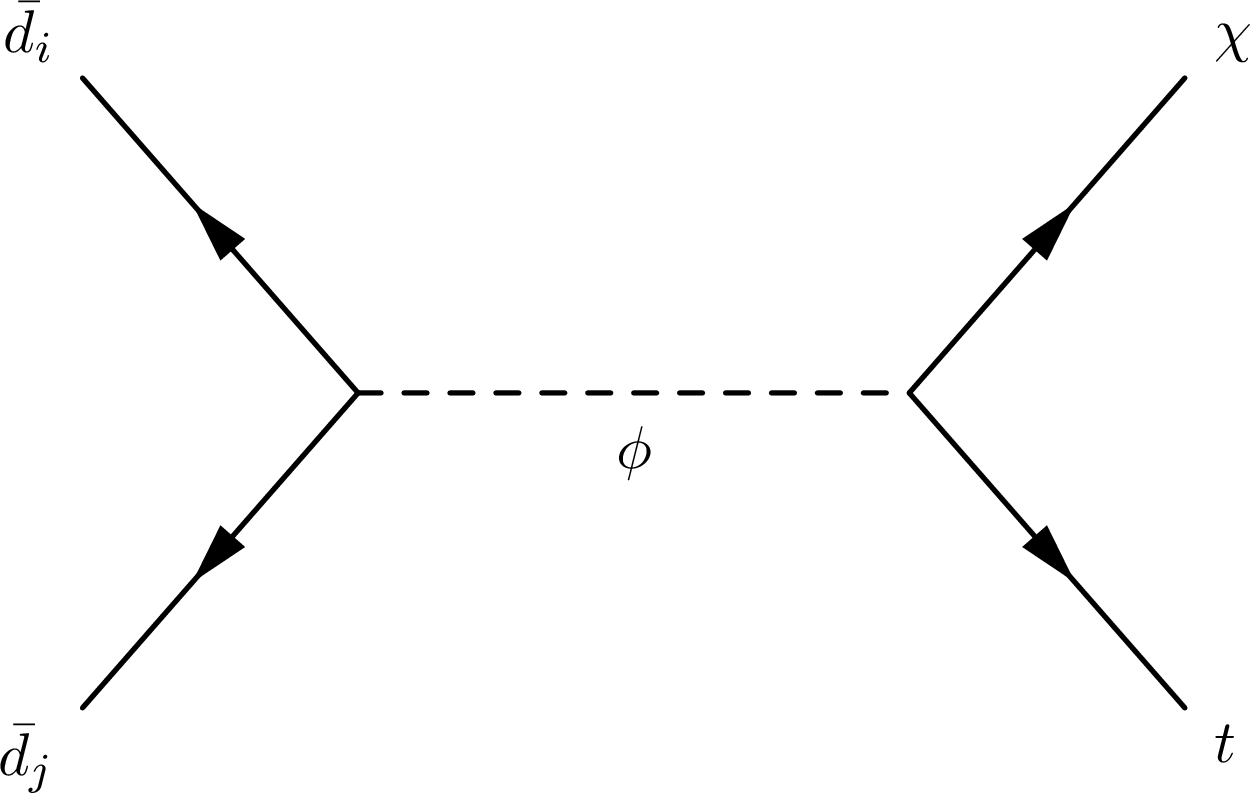
png pdf |
Figure 1-b:
Example of monotop production via a heavy scalar. |
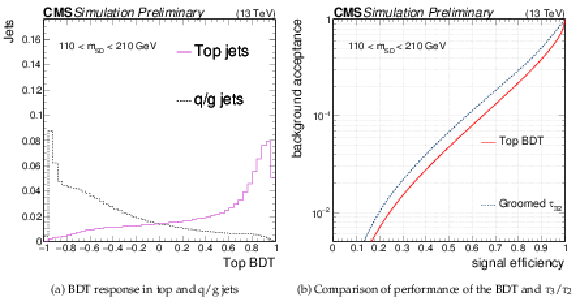
png pdf |
Figure 2:
Performance of the top quark tagging BDT in q/g jets and top quark jets. In both figures, the ${p_{\mathrm {T}}}$ spectra of jets are weighted to be flat, and the $m_\mathrm {SD}$ is required to be in the range 110-210 GeV. |
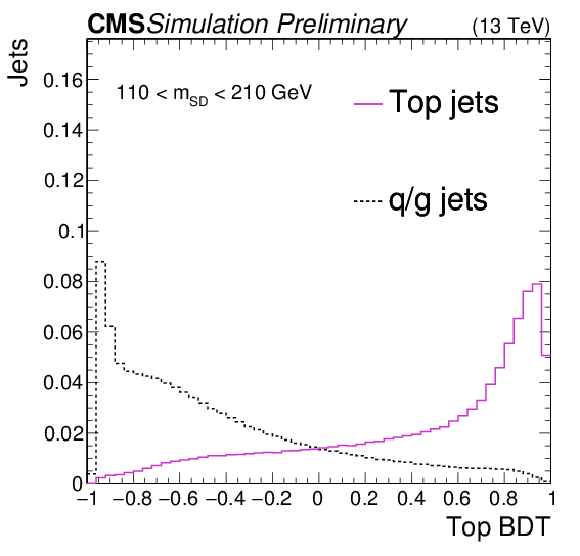
png pdf |
Figure 2-a:
Response of the top quark tagging BDT to q/g jets and top quark jets. The ${p_{\mathrm {T}}}$ spectra of jets are weighted to be flat, and the $m_\mathrm {SD}$ is required to be in the range 110-210 GeV. |
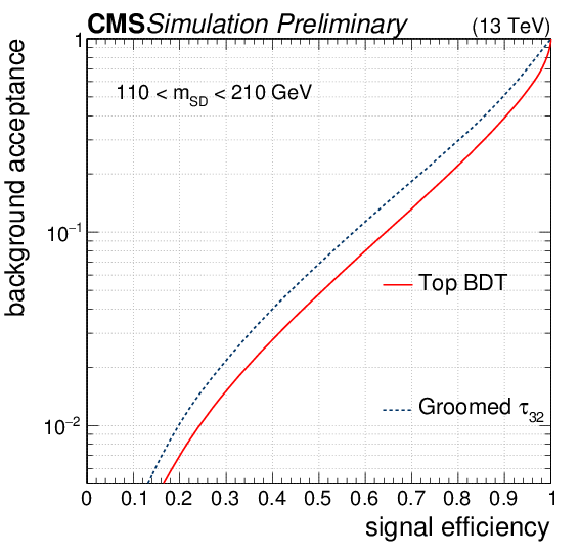
png pdf |
Figure 2-b:
Performance of the top quark tagging BDT in q/g jets and top quark jets. The ${p_{\mathrm {T}}}$ spectra of jets are weighted to be flat, and the $m_\mathrm {SD}$ is required to be in the range 110-210 GeV. |
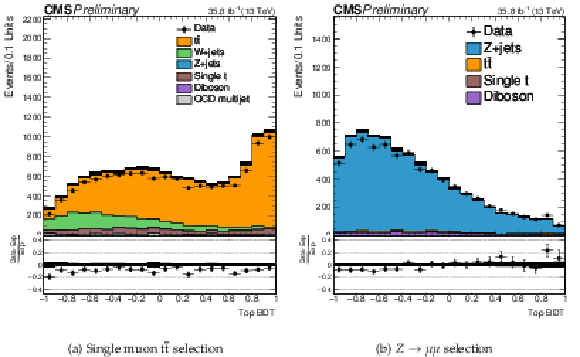
png pdf |
Figure 3:
Comparison of the BDT response in data and simulation. The shape of the response is observed to agree well between data and simulation, both in top quark jets and non-top quark jets. The grey band represents the statistical uncertainty of the simulation. |

png pdf |
Figure 3-a:
Comparison of the BDT response in data and simulation. The shape of the response is observed to agree well between data and simulation in top quark jets. The grey band represents the statistical uncertainty of the simulation. |
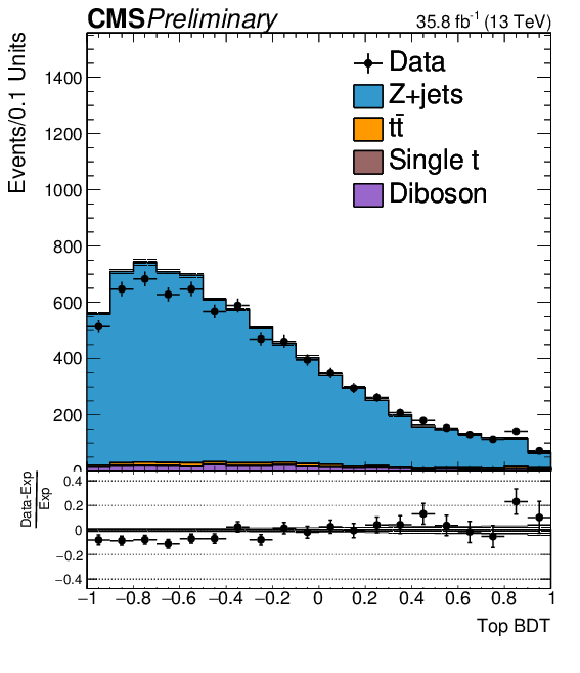
png pdf |
Figure 3-b:
Comparison of the BDT response in data and simulation. The shape of the response is observed to agree well between data and simulation in non-top quark jets. The grey band represents the statistical uncertainty of the simulation. |
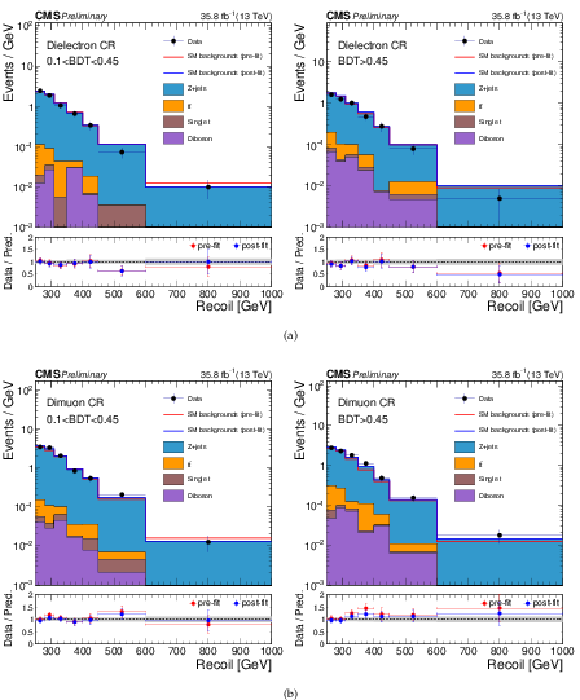
png pdf |
Figure 4:
Comparison between data and SM predictions in the control regions before and after performing the simultaneous fit to the different control regions and signal region. Each bin shows the event yields divided by the width of the bin. Plot (a) corresponds to the dielectron control region, and plot (b) corresponds to the dimuon control region. The blue solid line represents the sum of the SM background contributions normalized to their post-fit yields. The red solid line represents the sum of the SM background contributions normalized to the theoretical prediction. The stacked histograms show the individual SM background distributions after the fit is performed. The gray band indicates the post-fit uncertainty after propagating all the systematic uncertainties in the fit. |
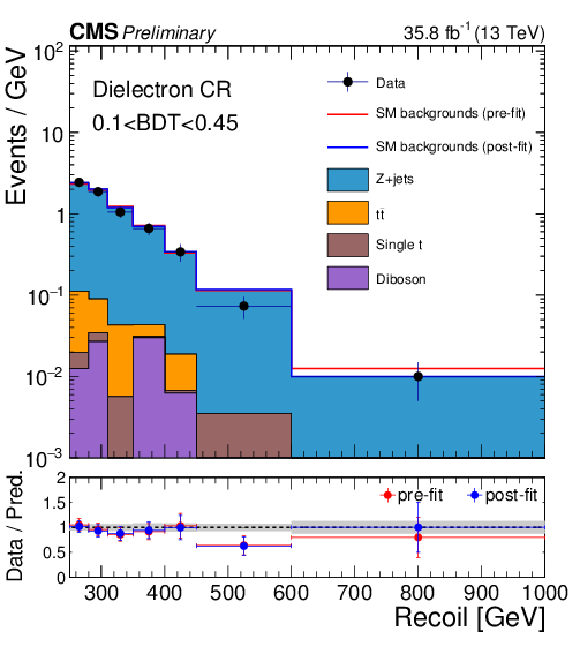
png pdf |
Figure 4-a:
Comparison between data and SM predictions in the control regions before and after performing the simultaneous fit to the different control regions and signal region. Each bin shows the event yields divided by the width of the bin. The plot corresponds to the dielectron control region for 0.1 $<$ BDT $<$ 0.45. The blue solid line represents the sum of the SM background contributions normalized to their post-fit yields. The red solid line represents the sum of the SM background contributions normalized to the theoretical prediction. The stacked histograms show the individual SM background distributions after the fit is performed. The gray band indicates the post-fit uncertainty after propagating all the systematic uncertainties in the fit. |
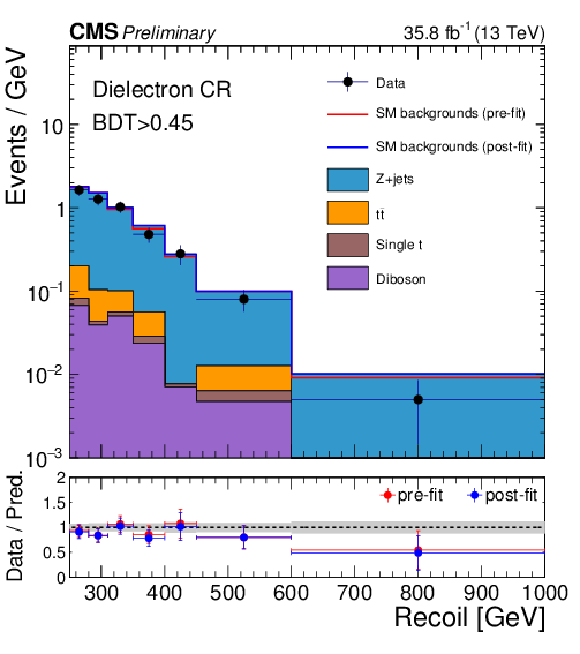
png pdf |
Figure 4-b:
Comparison between data and SM predictions in the control regions before and after performing the simultaneous fit to the different control regions and signal region. Each bin shows the event yields divided by the width of the bin. The plot corresponds to the dielectron control region for BDT $>$ 0.45. The blue solid line represents the sum of the SM background contributions normalized to their post-fit yields. The red solid line represents the sum of the SM background contributions normalized to the theoretical prediction. The stacked histograms show the individual SM background distributions after the fit is performed. The gray band indicates the post-fit uncertainty after propagating all the systematic uncertainties in the fit. |
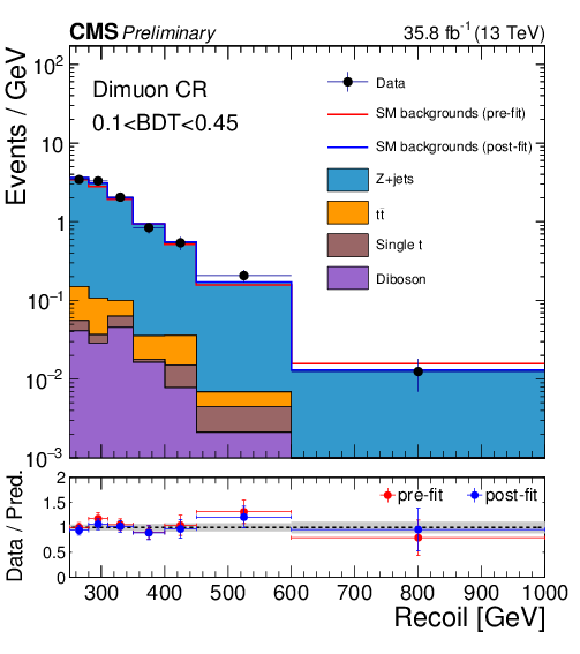
png pdf |
Figure 4-c:
Comparison between data and SM predictions in the control regions before and after performing the simultaneous fit to the different control regions and signal region. Each bin shows the event yields divided by the width of the bin. The plot corresponds to the dimuon control region for 0.1 $<$ BDT $<$ 0.45. The blue solid line represents the sum of the SM background contributions normalized to their post-fit yields. The red solid line represents the sum of the SM background contributions normalized to the theoretical prediction. The stacked histograms show the individual SM background distributions after the fit is performed. The gray band indicates the post-fit uncertainty after propagating all the systematic uncertainties in the fit. |
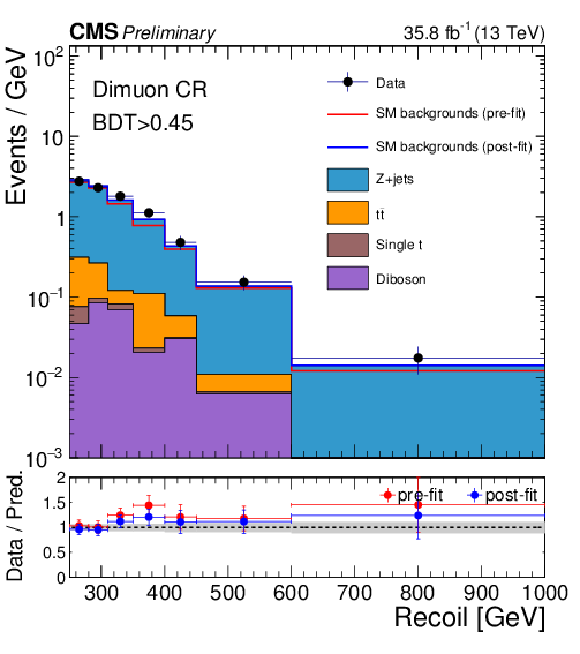
png pdf |
Figure 4-d:
Comparison between data and SM predictions in the control regions before and after performing the simultaneous fit to the different control regions and signal region. Each bin shows the event yields divided by the width of the bin. The plot corresponds to the dimuon control region for BDT $>$ 0.45. The blue solid line represents the sum of the SM background contributions normalized to their post-fit yields. The red solid line represents the sum of the SM background contributions normalized to the theoretical prediction. The stacked histograms show the individual SM background distributions after the fit is performed. The gray band indicates the post-fit uncertainty after propagating all the systematic uncertainties in the fit. |
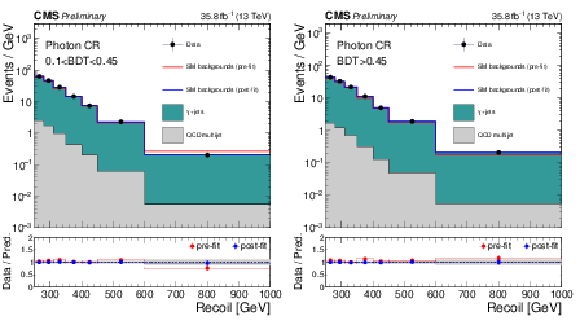
png pdf |
Figure 5:
Comparison between data and SM predictions in the photon control regions before and after performing the simultaneous fit to the different control regions and signal region. Each bin shows the event yields divided by the width of the bin. The blue solid line represents the sum of the SM background contributions normalized to their post-fit yields. The red solid line represents the sum of the SM background contributions normalized to the theoretical prediction. The stacked histograms show the individual SM background distributions after the fit is performed. The gray band indicates the post-fit uncertainty after propagating all the systematic uncertainties in the fit. |

png pdf |
Figure 5-a:
Comparison between data and SM predictions in the photon control regions before and after performing the simultaneous fit to the different control regions and signal region, for 0.1 $<$ BDT $<$ 0.45. Each bin shows the event yields divided by the width of the bin. The blue solid line represents the sum of the SM background contributions normalized to their post-fit yields. The red solid line represents the sum of the SM background contributions normalized to the theoretical prediction. The stacked histograms show the individual SM background distributions after the fit is performed. The gray band indicates the post-fit uncertainty after propagating all the systematic uncertainties in the fit. |
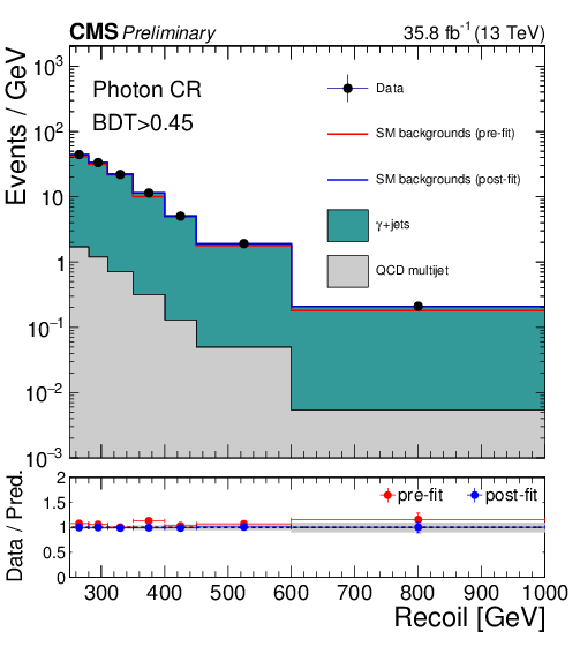
png pdf |
Figure 5-b:
Comparison between data and SM predictions in the photon control regions before and after performing the simultaneous fit to the different control regions and signal region, for BDT $>$ 0.45. Each bin shows the event yields divided by the width of the bin. The blue solid line represents the sum of the SM background contributions normalized to their post-fit yields. The red solid line represents the sum of the SM background contributions normalized to the theoretical prediction. The stacked histograms show the individual SM background distributions after the fit is performed. The gray band indicates the post-fit uncertainty after propagating all the systematic uncertainties in the fit. |
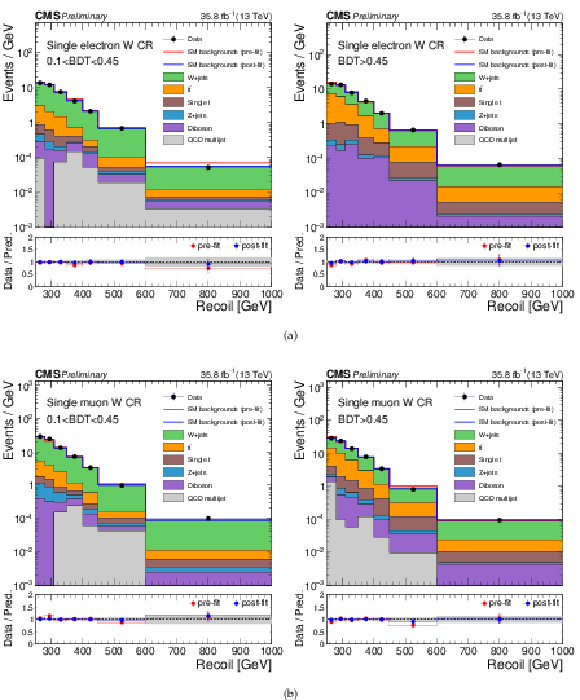
png pdf |
Figure 6:
Comparison between data and SM predictions in the control regions before and after performing the simultaneous fit to the different control regions and signal region. Each bin shows the event yields divided by the width of the bin. Plot (a) corresponds to the single electron anti-b-tagged control region and plot (b) corresponds to the single muon anti-b-tagged control region. The blue solid line represents the sum of the SM background contributions normalized to their post-fit yields. The red solid line represents the sum of the SM background contributions normalized to the theoretical prediction. The stacked histograms show the individual SM background distributions after the fit is performed. The gray band indicates the one standard deviation uncertainty on the prediction that also includes systematic uncertainties. |
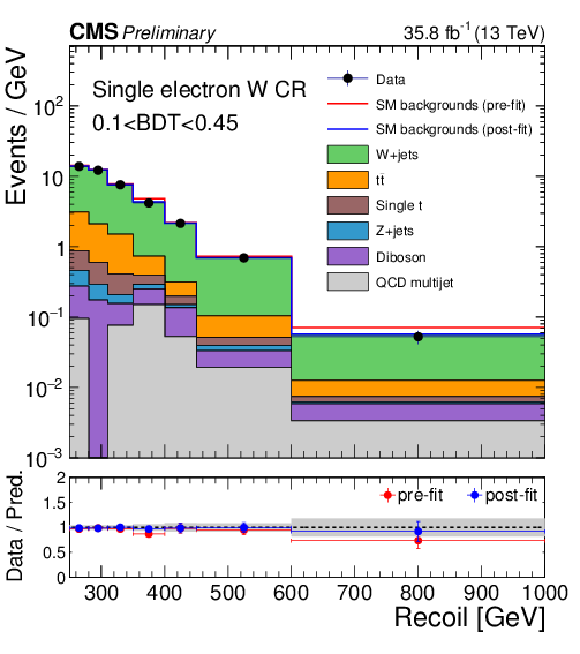
png pdf |
Figure 6-a:
Comparison between data and SM predictions in the control regions before and after performing the simultaneous fit to the different control regions and signal region. Each bin shows the event yields divided by the width of the bin. The plot corresponds to the single electron anti-b-tagged control region, for 0.1 $<$ BDT $<$ 0.45. The blue solid line represents the sum of the SM background contributions normalized to their post-fit yields. The red solid line represents the sum of the SM background contributions normalized to the theoretical prediction. The stacked histograms show the individual SM background distributions after the fit is performed. The gray band indicates the one standard deviation uncertainty on the prediction that also includes systematic uncertainties. |
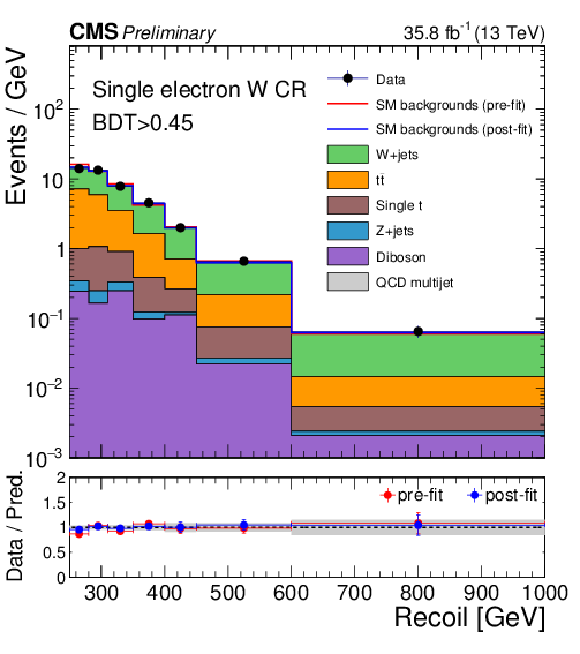
png pdf |
Figure 6-b:
Comparison between data and SM predictions in the control regions before and after performing the simultaneous fit to the different control regions and signal region. Each bin shows the event yields divided by the width of the bin. The plot corresponds to the single electron anti-b-tagged control region, for BDT $>$ 0.45. The blue solid line represents the sum of the SM background contributions normalized to their post-fit yields. The red solid line represents the sum of the SM background contributions normalized to the theoretical prediction. The stacked histograms show the individual SM background distributions after the fit is performed. The gray band indicates the one standard deviation uncertainty on the prediction that also includes systematic uncertainties. |
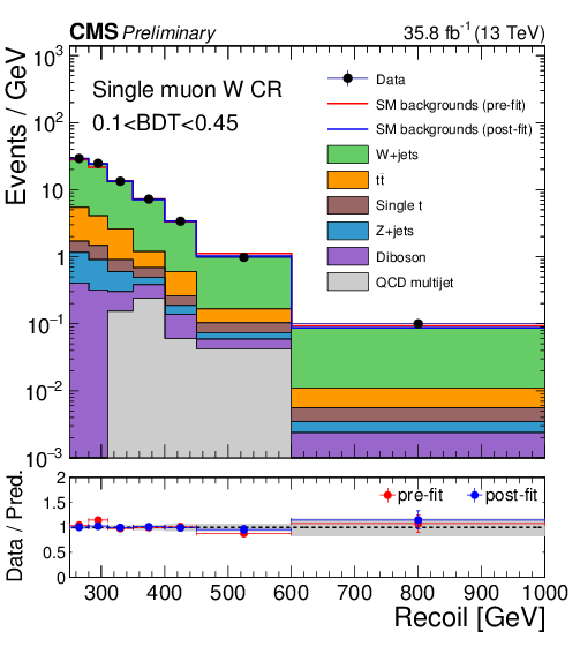
png pdf |
Figure 6-c:
Comparison between data and SM predictions in the control regions before and after performing the simultaneous fit to the different control regions and signal region. Each bin shows the event yields divided by the width of the bin. The plot corresponds to the single muon anti-b-tagged control region, for 0.1 $<$ BDT $<$ 0.45. The blue solid line represents the sum of the SM background contributions normalized to their post-fit yields. The red solid line represents the sum of the SM background contributions normalized to the theoretical prediction. The stacked histograms show the individual SM background distributions after the fit is performed. The gray band indicates the one standard deviation uncertainty on the prediction that also includes systematic uncertainties. |
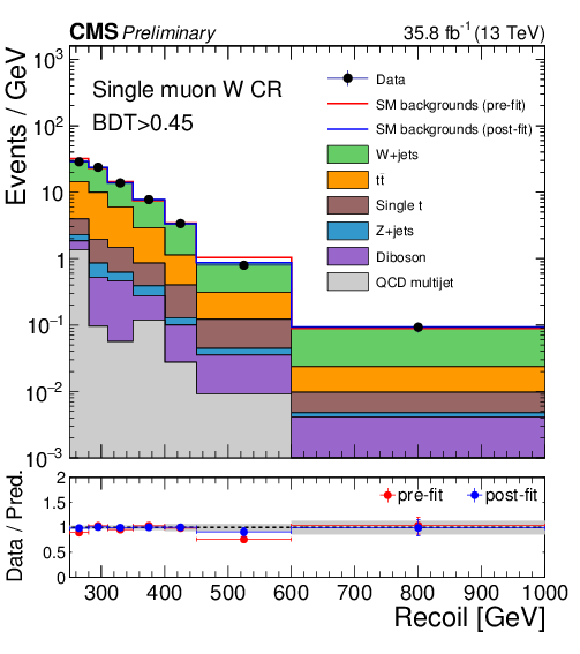
png pdf |
Figure 6-d:
Comparison between data and SM predictions in the control regions before and after performing the simultaneous fit to the different control regions and signal region. Each bin shows the event yields divided by the width of the bin. The plot corresponds to the single muon anti-b-tagged control region, for BDT $>$ 0.45. The blue solid line represents the sum of the SM background contributions normalized to their post-fit yields. The red solid line represents the sum of the SM background contributions normalized to the theoretical prediction. The stacked histograms show the individual SM background distributions after the fit is performed. The gray band indicates the one standard deviation uncertainty on the prediction that also includes systematic uncertainties. |
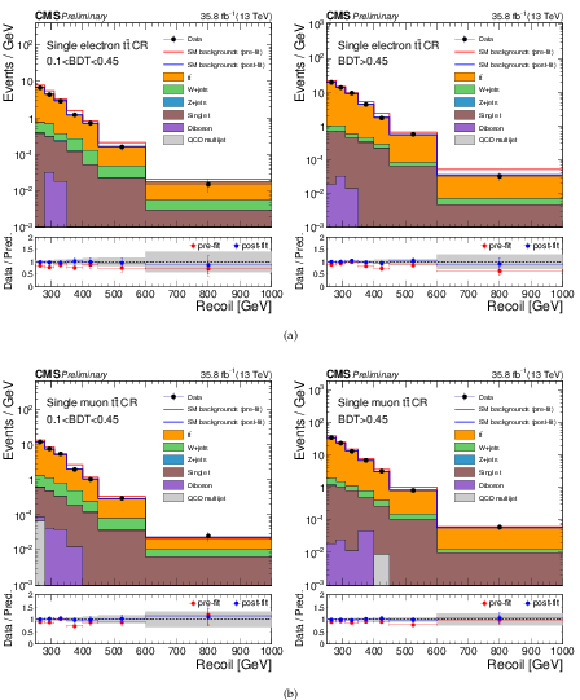
png pdf |
Figure 7:
Comparison between data and SM predictions in the control regions before and after performing the simultaneous fit to the different control regions and signal region. Each bin shows the event yields divided by the width of the bin. Plot (a) corresponds to the single electron b-tagged control region and plot (b) corresponds to the single muon b-tagged control region. The blue solid line represents the sum of the SM background contributions normalized to their post-fit yields. The red solid line represents the sum of the SM background contributions normalized to the theoretical prediction. The stacked histograms show the individual SM background distributions after the fit is performed. The gray band indicates the post-fit uncertainty after propagating all the systematic uncertainties in the fit. |
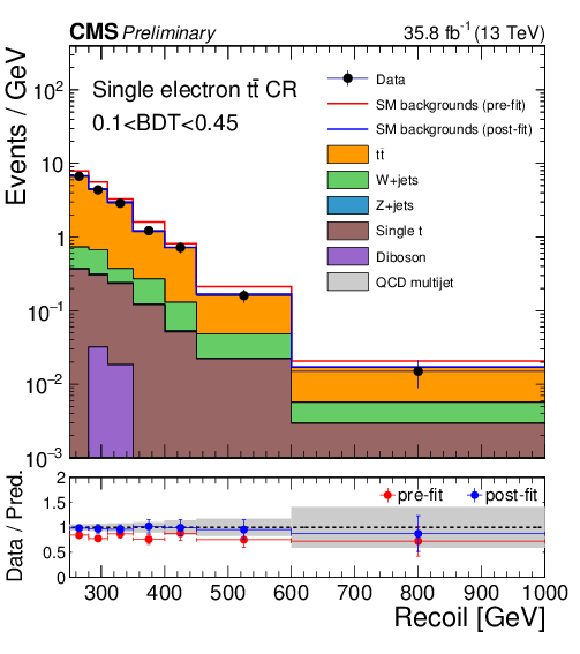
png pdf |
Figure 7-a:
Comparison between data and SM predictions in the control regions before and after performing the simultaneous fit to the different control regions and signal region. Each bin shows the event yields divided by the width of the bin. The plot corresponds to the single electron b-tagged control region, for 0.1 $<$ BDT $<$ 0.45. The blue solid line represents the sum of the SM background contributions normalized to their post-fit yields. The red solid line represents the sum of the SM background contributions normalized to the theoretical prediction. The stacked histograms show the individual SM background distributions after the fit is performed. The gray band indicates the post-fit uncertainty after propagating all the systematic uncertainties in the fit. |
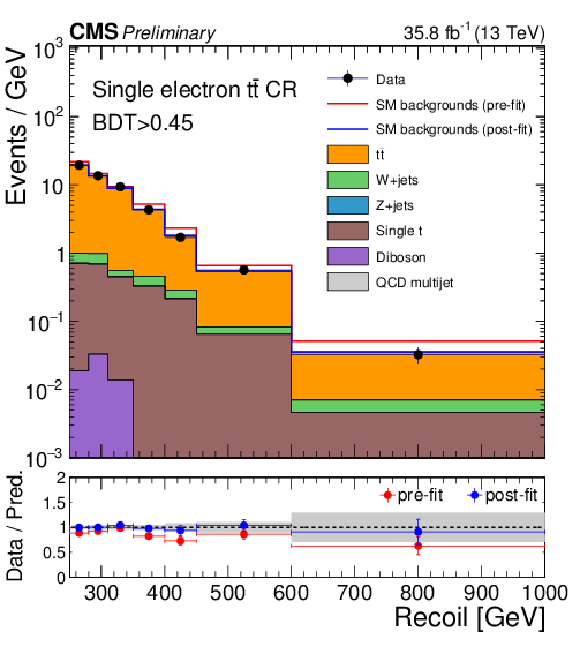
png pdf |
Figure 7-b:
Comparison between data and SM predictions in the control regions before and after performing the simultaneous fit to the different control regions and signal region. Each bin shows the event yields divided by the width of the bin. The plot corresponds to the single electron b-tagged control region, for BDT $>$ 0.45. The blue solid line represents the sum of the SM background contributions normalized to their post-fit yields. The red solid line represents the sum of the SM background contributions normalized to the theoretical prediction. The stacked histograms show the individual SM background distributions after the fit is performed. The gray band indicates the post-fit uncertainty after propagating all the systematic uncertainties in the fit. |
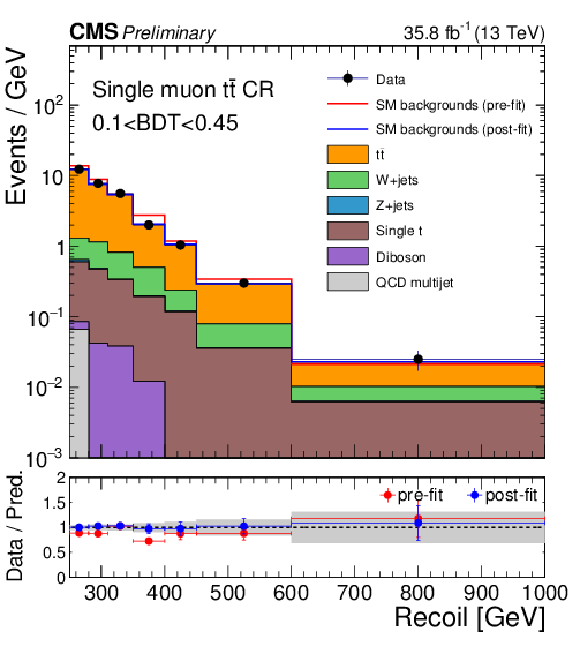
png pdf |
Figure 7-c:
Comparison between data and SM predictions in the control regions before and after performing the simultaneous fit to the different control regions and signal region. Each bin shows the event yields divided by the width of the bin. The plot corresponds to the single muon b-tagged control region, for 0.1 $<$ BDT $<$ 0.45. The blue solid line represents the sum of the SM background contributions normalized to their post-fit yields. The red solid line represents the sum of the SM background contributions normalized to the theoretical prediction. The stacked histograms show the individual SM background distributions after the fit is performed. The gray band indicates the post-fit uncertainty after propagating all the systematic uncertainties in the fit. |
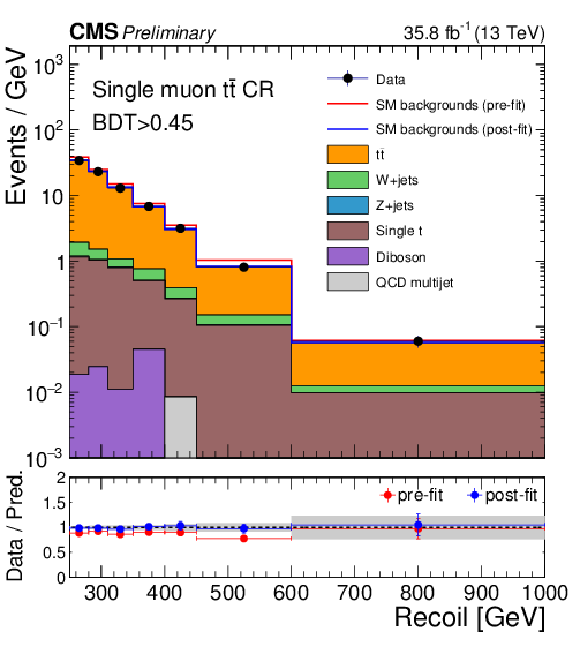
png pdf |
Figure 7-d:
Comparison between data and SM predictions in the control regions before and after performing the simultaneous fit to the different control regions and signal region. Each bin shows the event yields divided by the width of the bin. The plot corresponds to the single muon b-tagged control region, for BDT $>$ 0.45. The blue solid line represents the sum of the SM background contributions normalized to their post-fit yields. The red solid line represents the sum of the SM background contributions normalized to the theoretical prediction. The stacked histograms show the individual SM background distributions after the fit is performed. The gray band indicates the post-fit uncertainty after propagating all the systematic uncertainties in the fit. |
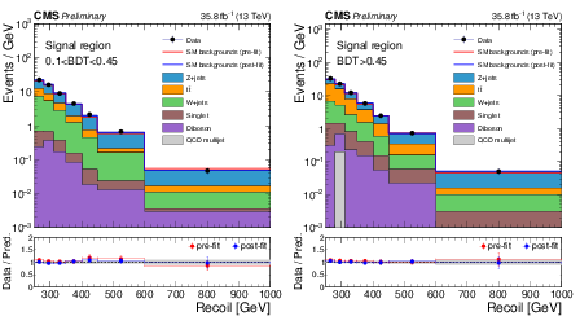
png pdf |
Figure 8:
Distribution of ${ {p_{\mathrm {T}}} ^\text {miss}}$ from SM backgrounds and data in the signal region after simultaneously fitting in the signal region and all control regions. Each bin shows the event yields divided by the width of the bin. The stacked histograms show the individual SM background distributions after the fit is performed. The blue solid line represents the sum of the SM background contributions normalized to their post-fit yields. The red solid line represents the sum of the SM background contributions normalized to the theoretical prediction. The gray bands indicate the post-fit uncertainty in the background, assuming no signal. |

png pdf |
Figure 8-a:
Distribution of ${ {p_{\mathrm {T}}} ^\text {miss}}$ from SM backgrounds and data in the signal region after simultaneously fitting in the signal region and all control regions. Each bin shows the event yields divided by the width of the bin. The stacked histograms show the individual SM background distributions after the fit is performed. The blue solid line represents the sum of the SM background contributions normalized to their post-fit yields. The red solid line represents the sum of the SM background contributions normalized to the theoretical prediction. The gray bands indicate the post-fit uncertainty in the background, assuming no signal. |
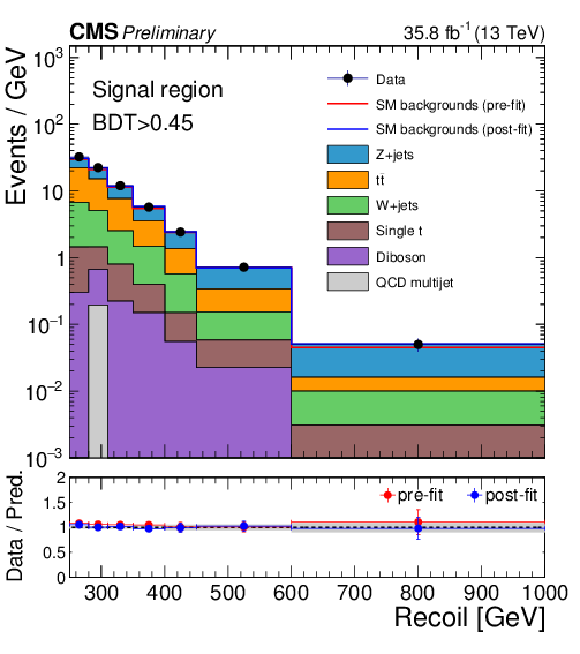
png pdf |
Figure 8-b:
Distribution of ${ {p_{\mathrm {T}}} ^\text {miss}}$ from SM backgrounds and data in the signal region after simultaneously fitting in the signal region and all control regions. Each bin shows the event yields divided by the width of the bin. The stacked histograms show the individual SM background distributions after the fit is performed. The blue solid line represents the sum of the SM background contributions normalized to their post-fit yields. The red solid line represents the sum of the SM background contributions normalized to the theoretical prediction. The gray bands indicate the post-fit uncertainty in the background, assuming no signal. |
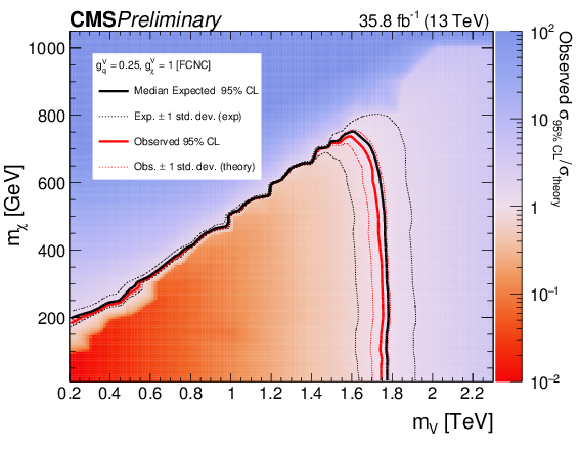
png pdf |
Figure 9:
Results for the FCNC interpretation presented in the two-dimensional plane spanned by the mediator and dark matter masses. The mediator is assumed to have purely vector couplings to quarks and dark matter. The observed exclusion range (red solid line) is shown. The red dashed lines show the cases in which the predicted cross section is shifted by the assigned theory uncertainty. The expected exclusion range is indicated by a black solid line, demonstrating the search sensitivity of the analysis. The experimental uncertainties are shown in black dashed lines. |
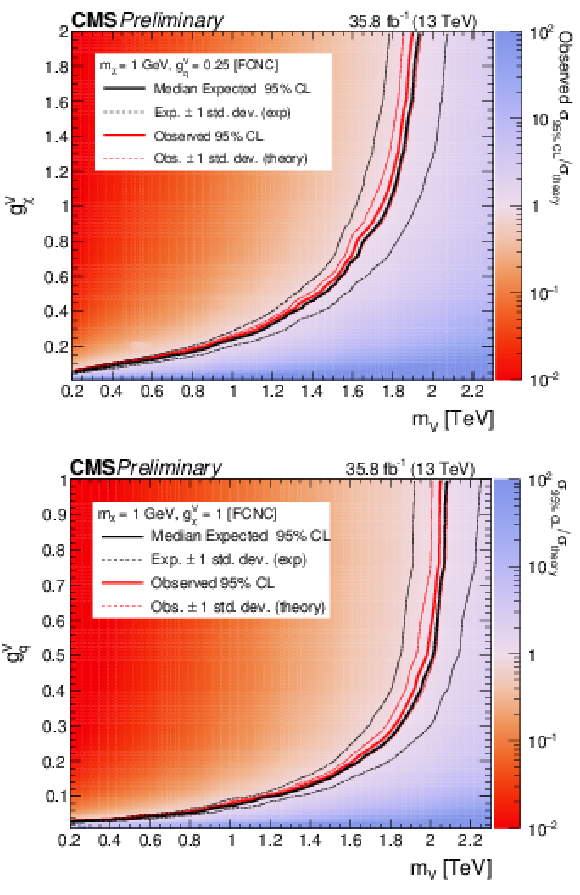
png pdf |
Figure 10:
Results for the FCNC interpretation presented in the two-dimensional plane spanned by the mediator mass and the coupling between the mediator and dark matter (top) or quarks (bottom). The mediator is assumed to have purely vector couplings. The observed exclusion range (red solid line) is shown. The red dashed lines show the cases in which the predicted cross section is shifted by the assigned theory uncertainty. The expected exclusion range is indicated by a black solid line, demonstrating the search sensitivity of the analysis. The experimental uncertainties are shown in black dashed lines. |
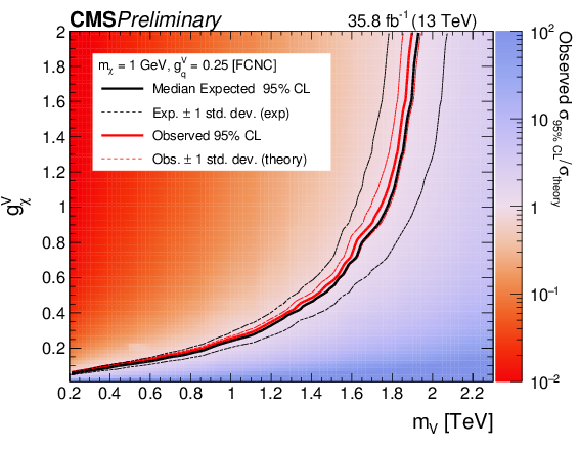
png pdf |
Figure 10-a:
Results for the FCNC interpretation presented in the two-dimensional plane spanned by the mediator mass and the coupling between the mediator and dark matter. The mediator is assumed to have purely vector couplings. The observed exclusion range (red solid line) is shown. The red dashed lines show the cases in which the predicted cross section is shifted by the assigned theory uncertainty. The expected exclusion range is indicated by a black solid line, demonstrating the search sensitivity of the analysis. The experimental uncertainties are shown in black dashed lines. |
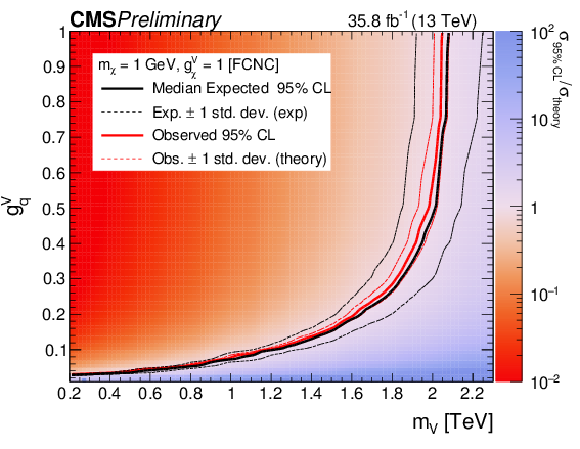
png pdf |
Figure 10-b:
Results for the FCNC interpretation presented in the two-dimensional plane spanned by the mediator mass and the coupling between the mediator and quarks. The mediator is assumed to have purely vector couplings. The observed exclusion range (red solid line) is shown. The red dashed lines show the cases in which the predicted cross section is shifted by the assigned theory uncertainty. The expected exclusion range is indicated by a black solid line, demonstrating the search sensitivity of the analysis. The experimental uncertainties are shown in black dashed lines. |
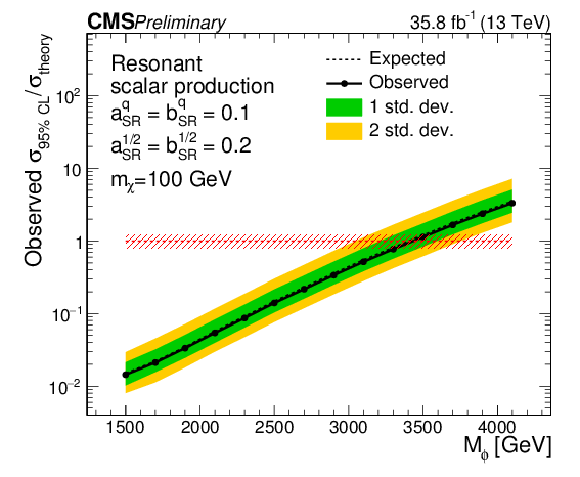
png pdf |
Figure 11:
Results assuming a resonant interpretation of the monotop signature. Shown are upper limits as a function of the mass of the scalar particle $S$, assuming fixed $a_\text {SR} = b_\text {SR}= $ 0.1. The limits are placed at a confidence level of 95%. The green and yellow bands represent one and two standard deviations of experimental uncertainties, respectively. The red shaded band represents the 20% signal cross section uncertainty. |
| Tables | |
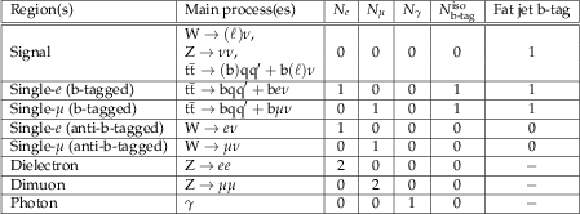
png pdf |
Table 1:
Summary of the selection criteria used in the signal and CRs. Symbols $(\mathrm {b})$ and $(\ell )$ respectively refer to cases where the b-quark and lepton are not identified. $N_e,N_\mu ,\mathrm {and}N_\gamma $ refer to the number of selected electrons, muons, and photons, respectively. The number of b-tagged narrow jets that are isolated from the fat jet are denoted with $N_{\text {b-tag}}^\text {iso}$. |
| Summary |
|
A search for dark matter in the monotop final state is performed. The data are found to be in agreement with the standard model prediction. Results are interpreted in terms of limits on the production cross section of dark matter particles via a neutral flavor-changing interaction or via the decay of a colored, scalar resonance together with a single top quark. For the nonresonant model, assuming $m_\chi = $ 1 GeV, $g_{V_u}= $ 0.25, and $g_{V_\chi}= $ 1, flavor-changing neutral currents of $m_V< $ 1.75 TeV are excluded at 95% confidence level. For the resonant model, scalar fields with $m_\phi < $ 3.4 TeV are excluded. |
| References | ||||
| 1 | LUX Collaboration | Improved Limits on Scattering of Weakly Interacting Massive Particles from Reanalysis of 2013 LUX Data | PRL 116 (2016) 161301 | 1512.03506 |
| 2 | J. Andrea, B. Fuks, and F. Maltoni | Monotops at the LHC | PRD84 (2011) 074025 | 1106.6199 |
| 3 | CDF Collaboration | Search for a dark matter candidate produced in association with a single top quark in $ p\overline{p} $ collisions at $ \sqrt{s}= $ 1.96 TeV | PRL 108 (2012) 201802 | 1202.5653 |
| 4 | CMS Collaboration | Search for monotop signatures in proton-proton collisions at $ \sqrt{s}= $ 8 TeV | PRL 114 (2015) 101801 | CMS-B2G-12-022 1410.1149 |
| 5 | ATLAS Collaboration | Search for invisible particles produced in association with single-top-quarks in proton-proton collisions at $ \sqrt{s}= $ 8 TeV with the atlas detector | EPJC75 (2015) 79 | 1410.5404 |
| 6 | J.-L. Agram et al. | Monotop phenomenology at the Large Hadron Collider | Phys.Rev. D89 (2014) 014028 | 1311.6478 |
| 7 | I. Boucheneb, G. Cacciapaglia, A. Deandrea, and B. Fuks | Revisiting monotop production at the LHC | JHEP 01 (2015) 017 | 1407.7529 |
| 8 | CMS Collaboration | The CMS experiment at the CERN LHC | JINST 3 (2008) S08004 | CMS-00-001 |
| 9 | CMS Collaboration | Particle-flow reconstruction and global event description with the CMS detector | Submitted to JINST | CMS-PRF-14-001 1706.04965 |
| 10 | CMS Collaboration | A Cambridge-Aachen (C-A) based Jet Algorithm for boosted top-jet tagging | CDS | |
| 11 | D. Berteloni, P. Harris, M. Low, and N. Tran | Pileup per particle identification | JHEP 59 (2014) 059 | 1407.6013 |
| 12 | CMS Collaboration | Determination of jet energy calibration and transverse momentum resolution in CMS | JINST 6 (2011) 11002 | CMS-JME-10-011 1107.4277 |
| 13 | A. J. Larkoski, S. Marzani, G. Soyez, and J. Thaler | Soft Drop | JHEP 05 (2014) 146 | 1402.2657 |
| 14 | CMS Collaboration | Identification of b-quark jets with the CMS experiment | JINST 8 (2012) P04013 | |
| 15 | CMS Collaboration | Performance of b tagging at $ \sqrt{s} = $ 8 TeV in multijet, $ \mathrm{t}\bar{\mathrm{t}} $, and boosted topology events. | CMS-PAS-BTV-13-001 | CMS-PAS-BTV-13-001 |
| 16 | J. Thaler and K. Tilburg | Identifying boosted objects with $ n $-subjettiness | JHEP 03 (2011) 015 | 1011.2268 |
| 17 | C. Anders et al. | Benchmarking an even better top tagger algorithm | PRD89 (2014) 074047 | 1312.1504 |
| 18 | I. Moult, L. Necib, and J. Thaler | New Angles on Energy Correlation Functions | JHEP 12 (2016) 153 | 1609.07483 |
| 19 | M. Cacciari, G. P. Salam, and G. Soyez | The anti-k(t) jet clustering algorithm | JHEP 04 (2008) 063 | 0802.1189 |
| 20 | CMS Collaboration | Particle--flow event reconstruction in CMS and performance for jets, taus, and $ E_{\mathrm{T}}^{\text{miss}} $ | CDS | |
| 21 | CMS Collaboration | Performance of reconstruction and identification of tau leptons in their decays to hadrons and tau neutrino in LHC Run-2 | CMS-PAS-TAU-16-002 | CMS-PAS-TAU-16-002 |
| 22 | J. Alwall et al. | The automated computation of tree-level and next-to-leading order differential cross sections, and their matching to parton shower simulations | JHEP 07 (2014) 079 | 1405.0301 |
| 23 | P. Nason | A new method for combining NLO QCD with shower Monte Carlo algorithms | JHEP 11 (2004) 040 | hep-ph/0409146 |
| 24 | S. Frixione, P. Nason, and C. Oleari | Matching NLO QCD computations with parton shower simulations: the POWHEG method | JHEP 11 (2007) 070 | 0709.2092 |
| 25 | S. Alioli, P. Nason, C. Oleari, and E. Re | A general framework for implementing NLO calculations in shower Monte Carlo programs: the POWHEG BOX | JHEP 06 (2010) 043 | 1002.2581 |
| 26 | T. Sjostrand et al. | An Introduction to PYTHIA 8.2 | CPC 191 (2015) 159 | 1410.3012 |
| 27 | M. L. Mangano, M. Moretti, F. Piccinini, and M. Treccani | Matching matrix elements and shower evolution for top-quark production in hadronic collisions | JHEP 01 (2007) 013 | hep-ph/0611129 |
| 28 | R. Frederix and S. Frixione | Merging meets matching in MC@NLO | JHEP 12 (2012) 061 | 1209.6215 |
| 29 | J. H. Kuhn, A. Kulesza, S. Pozzorini, and M. Schulze | Electroweak corrections to hadronic photon production at large transverse momenta | JHEP 03 (2006) 059 | hep-ph/0508253 |
| 30 | S. Kallweit et al. | NLO electroweak automation and precise predictions for W+multijet production at the LHC | JHEP 04 (2015) 012 | 1412.5157 |
| 31 | S. Kallweit et al. | NLO QCD+EW automation and precise predictions for V+multijet production | in 50th Rencontres de Moriond on QCD and High Energy Interactions La Thuile, Italy, March 21-28, 2015 2015 | 1505.05704 |
| 32 | S. Kallweit et al. | NLO QCD+EW predictions for V + jets including off-shell vector-boson decays and multijet merging | JHEP 04 (2016) 021 | 1511.08692 |
| 33 | NNPDF Collaboration | Parton distributions for the LHC Run II | JHEP 04 (2015) 040 | 1410.8849 |
| 34 | GEANT4 Collaboration | GEANT4: A Simulation toolkit | NIMA506 (2003) 250 | |
| 35 | CMS Collaboration | CMS Luminosity Measurements for the 2016 Data Taking Period | CMS-PAS-LUM-17-001 | CMS-PAS-LUM-17-001 |
| 36 | CMS Collaboration | Performance of Photon Reconstruction and Identification with the CMS Detector in Proton-Proton Collisions at $ \sqrt{s} = $ 8 TeV | JINST 10 (2015) P08010 | CMS-EGM-14-001 1502.02702 |
| 37 | CMS Collaboration | Differential cross section measurements for the production of a W boson in association with jets in proton-proton collisions at $ \sqrt s= $ 7 TeV | PLB741 (2015) 12 | CMS-SMP-12-023 1406.7533 |
| 38 | CMS Collaboration | Measurement of the production cross section for a W boson and two b jets in pp collisions at $ \sqrt{s} = $ 7 TeV | PLB735 (2014) 204 | CMS-SMP-12-026 1312.6608 |
| 39 | CMS Collaboration | Measurements of jet multiplicity and differential production cross sections of $ Z + $ jets events in proton-proton collisions at $ \sqrt{s} = $ 7 TeV | PRD91 (2015) 052008 | CMS-SMP-12-017 1408.3104 |
| 40 | CMS Collaboration | Measurement of the production cross sections for a Z boson and one or more b jets in pp collisions at $ \sqrt{s} = $ 7 TeV | JHEP 06 (2014) 120 | CMS-SMP-13-004 1402.1521 |
| 41 | CMS Collaboration | Observation of the associated production of a single top quark and a $ W $ boson in $ pp $ collisions at $ \sqrt s = $ 8 TeV | PRL 112 (2014) 231802 | CMS-TOP-12-040 1401.2942 |
| 42 | CMS Collaboration | Measurement of the ZZ production cross section and Z $ \to \ell^+\ell^-\ell'^+\ell'^- $ branching fraction in pp collisions at $ \sqrt s = $ 13TeV | PLB763 (2016) 280 | CMS-SMP-16-001 1607.08834 |
| 43 | CMS Collaboration | Measurement of the WZ production cross section in pp collisions at $ \sqrt s = $ 13 TeV | PLB766 (2017) 268 | CMS-SMP-16-002 1607.06943 |
| 44 | CMS Collaboration | Performance of the CMS missing transverse momentum reconstruction in pp data at $ \sqrt{s} = $ 8 TeV | JINST 10 (2015) P02006 | CMS-JME-13-003 1411.0511 |
| 45 | A. L. Read | Presentation of search results: The CL(s) technique | JPG28 (2002) 2693 | |

|
Compact Muon Solenoid LHC, CERN |

|

|

|

|

|

|